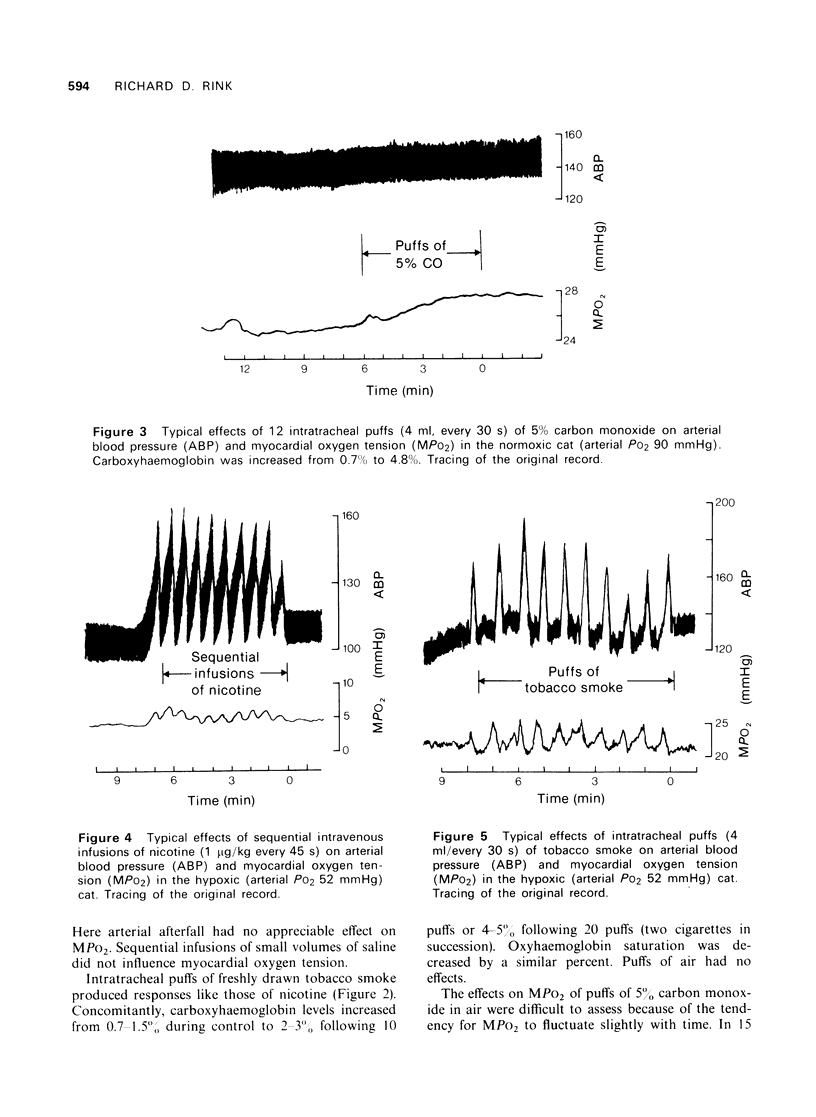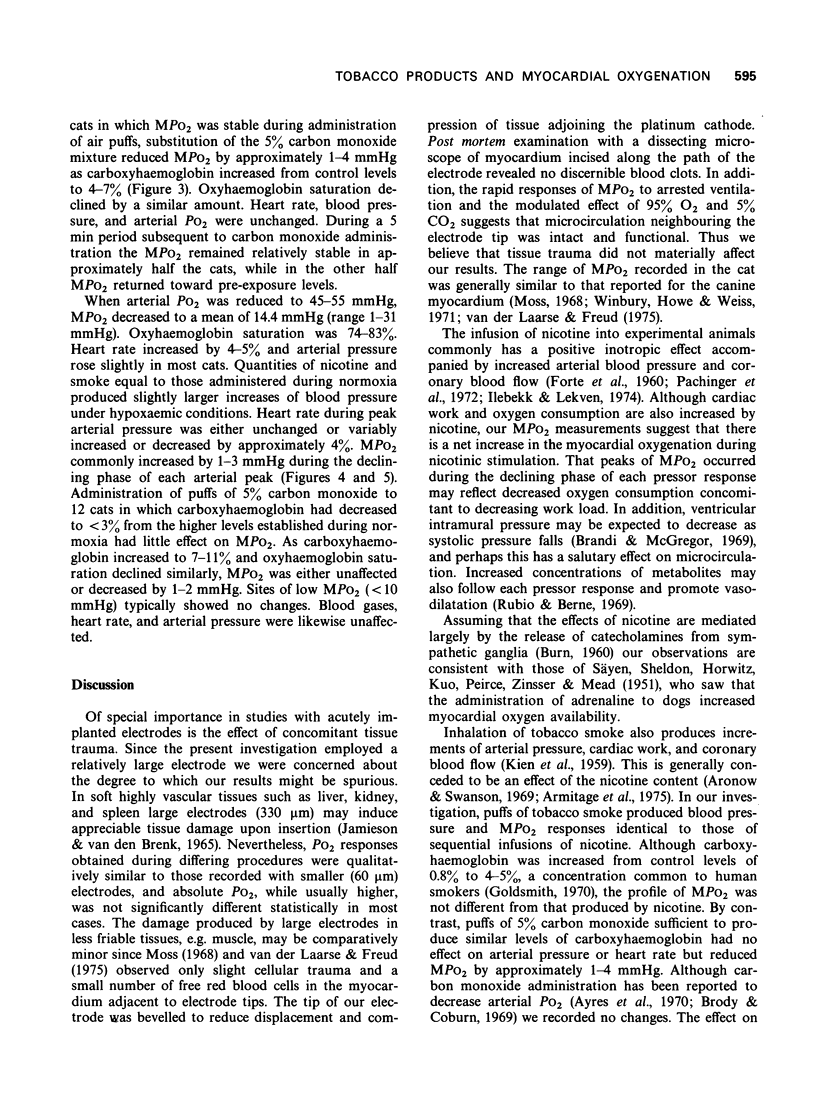Abstract
1 The acute effects of nicotine, tobacco smoke, and carbon monoxide on myocardial oxygen tension (MPo2) were estimated amperometrically in 33 anaesthetized open-chest cats with a glass-insulated 25 μm platinum cathode within a 22-gauge needle implanted in the left ventricular wall.
2 MPo2 was 1.6-60 mmHg (mean 23.5 mmHg) when arterial Po2 was >80 mmHg. Sequential intravenous infusions of nicotine (2-3 μg/kg every 45 s) or intracheal puffs (3-5 ml) of tobacco smoke commonly produced transitory increases (25-35 mmHg) of arterial pressure and 4-6 mmHg increments of MPo2. Intratracheal puffs (5 ml) of 5% carbon monoxide sufficient to increase carboxyhaemoglobin from 0.8 to 1.5% to 4-7% had no effect on arterial Po2 or blood pressure but typically decreased MPo2 by approximately 1-4 mmHg. Augmentation of MPo2 often succeeded carbon monoxide administration.
3 Arterial hypoxia (arterial Po2 < 60 mmHg) reduced mean MPo2 to 14.4 mmHg but anoxic levels were not observed. Pressor responses to nicotine and tobacco smoke were accompanied by small increases (usually 1-3 mmHg) of MPo2. Puffs of 5% carbon monoxide had less effect than during normoxia. Locations of low MPo2 (<10 mmHg) were unaffected as carboxyhaemoglobin was raised to 7-11% during hypoxaemia.
4 It is concluded that nicotine and tobacco smoke cause augmentation of myocardial oxygen supply, even during moderate hypoxaemia. By contrast, smoking dosages of carbon monoxide have the potential of producing a small reduction of MPo2 during normoxia, but the effect is negligible during moderate hypoxaemia.
Full text
PDF






Selected References
These references are in PubMed. This may not be the complete list of references from this article.
- Afonso S., Ansfield T. J., Berndt T. B., Rowe G. G. Coronary vasodilator responses to hypoxia before and after aminophylline. J Physiol. 1972 Mar;221(3):589–599. doi: 10.1113/jphysiol.1972.sp009769. [DOI] [PMC free article] [PubMed] [Google Scholar]
- Armitage A. K., Dollery C. T., George C. F., Houseman T. H., Lewis P. J., Turner D. M. Absorption and metabolism of nicotine from cigarettes. Br Med J. 1975 Nov 8;4(5992):313–316. doi: 10.1136/bmj.4.5992.313. [DOI] [PMC free article] [PubMed] [Google Scholar]
- Aronow W. S., Swanson A. J. The effect of low-nicotine cigarettes on angina pectoris. Ann Intern Med. 1969 Sep;71(3):599–601. doi: 10.7326/0003-4819-71-3-599. [DOI] [PubMed] [Google Scholar]
- Ayres S. M., Giannelli S., Jr, Mueller H. Myocardial and systemic responses to carboxyhemoglobin. Ann N Y Acad Sci. 1970 Oct 5;174(1):268–293. doi: 10.1111/j.1749-6632.1970.tb49795.x. [DOI] [PubMed] [Google Scholar]
- BURN J. H. Action of nicotine on the heart. Ann N Y Acad Sci. 1960 Sep 27;90:70–73. doi: 10.1111/j.1749-6632.1960.tb32618.x. [DOI] [PubMed] [Google Scholar]
- Brandi G., McGregor M. Intramural pressure in the left ventricle of the dog. Cardiovasc Res. 1969 Oct;3(4):472–475. doi: 10.1093/cvr/3.4.472. [DOI] [PubMed] [Google Scholar]
- Brody J. S., Coburn R. F. Carbon monoxide-induced arterial hypoxemia. Science. 1969 Jun 13;164(3885):1297–1298. doi: 10.1126/science.164.3885.1297. [DOI] [PubMed] [Google Scholar]
- FORTE I. E., WILLIAMS A. J., POTGIETER L., SCHMITTHENNER J. E., HAFKENSCHIEL J. H., RIEGEL C. Coronary blood flow and cardiac oxygen metabolism during nicotine-induced increases in left ventricular work. Ann N Y Acad Sci. 1960 Sep 27;90:174–185. doi: 10.1111/j.1749-6632.1960.tb32631.x. [DOI] [PubMed] [Google Scholar]
- Goldsmith J. R., Aronow W. S. Carbon monoxide and coronary heart disease: A review. Environ Res. 1975 Oct;10(2):236–248. doi: 10.1016/0013-9351(75)90087-0. [DOI] [PubMed] [Google Scholar]
- Goldsmith J. R. Contribution of motor vehicle exhaust, industry, and cigarette smoking to community carbon monoxide exposures. Ann N Y Acad Sci. 1970 Oct 5;174(1):122–134. doi: 10.1111/j.1749-6632.1970.tb49779.x. [DOI] [PubMed] [Google Scholar]
- Herbert D. A., Mitchell R. A. Blood gas tensions and acid-base balance in awake cats. J Appl Physiol. 1971 Mar;30(3):434–436. doi: 10.1152/jappl.1971.30.3.434. [DOI] [PubMed] [Google Scholar]
- Ilebekk A., Lekven J. Cardiac effects of nicotine in dogs. Scand J Clin Lab Invest. 1974 Apr;33(2):153–159. doi: 10.1080/00365517409082483. [DOI] [PubMed] [Google Scholar]
- Jamieson D., van den Brenk H. A. Electrode size and tissue pO2 measurement in rats exposed to air or high pressure oxygen. J Appl Physiol. 1965 May;20(3):514–518. doi: 10.1152/jappl.1965.20.3.514. [DOI] [PubMed] [Google Scholar]
- KIEN G. A., LASKER N., SHERROD T. R. Action of cigarette smoke on cardiovascular hemodynamics and oxygen utilization in the dog. J Pharmacol Exp Ther. 1958 Sep;124(1):35–42. [PubMed] [Google Scholar]
- Leb G., Derntl F., Robin E., Bing R. J. The effect of nicotine on effective and total coronary blood flow in the anesthetized closed-chest dog. J Pharmacol Exp Ther. 1970 May;173(1):138–144. [PubMed] [Google Scholar]
- Lösse B., Schuchhardt S., Niederle N. The oxygen pressure histogram in the left ventricular myocardium of the dog. Pflugers Arch. 1975 Apr 29;356(2):121–132. doi: 10.1007/BF00584292. [DOI] [PubMed] [Google Scholar]
- Martini J., Honig C. R. Direct measurement of intercapillary distance in beating rat heart in situ under various conditions of O 2 supply. Microvasc Res. 1969 Apr;1(3):244–256. doi: 10.1016/0026-2862(69)90026-0. [DOI] [PubMed] [Google Scholar]
- Moss A. J. Intramyocardial oxygen tension. Cardiovasc Res. 1968 Jul;2(3):314–318. doi: 10.1093/cvr/2.3.314. [DOI] [PubMed] [Google Scholar]
- Pachinger O., Hellberg K. D., Bing R. J. The effect of nicotine, propranolol, phentolamine, and hexamethonium on the coronary microcirculation of the cat. J Clin Pharmacol New Drugs. 1972 Nov-Dec;12(11):432–439. doi: 10.1002/j.1552-4604.1972.tb00243.x. [DOI] [PubMed] [Google Scholar]
- Rubio R., Berne R. M. Release of adenosine by the normal myocardium in dogs and its relationship to the regulation of coronary resistance. Circ Res. 1969 Oct;25(4):407–415. doi: 10.1161/01.res.25.4.407. [DOI] [PubMed] [Google Scholar]
- SAYEN J. J., KATCHER A. H., SHELDON W. F., GILBERT C. M., Jr The effect of levarterenol on polarographic myocardial oxygen, the epicardial electrocardiogram and contraction in nonischemic dog hearts and experimental acute regional ischemia. Circ Res. 1960 Jan;8:109–128. doi: 10.1161/01.res.8.1.109. [DOI] [PubMed] [Google Scholar]
- SAYEN J. J., SHELDON W. F., HORWITZ O., KUO P. T., PEIRCE G., ZINSSER H. F., MEAD J., Jr Studies of coronary disease in the experimental animal. II. Polarographic determinations of local oxygen availability in the dog's left ventricle during coronary occlusion and pure oxygen breathing. J Clin Invest. 1951 Sep;30(9):932–940. doi: 10.1172/JCI102514. [DOI] [PMC free article] [PubMed] [Google Scholar]
- Scharf S. M., Permutt S., Bromberger-Barnea B. Effects of hypoxic and CO hypoxia on isolated hearts. J Appl Physiol. 1975 Nov;39(5):752–758. doi: 10.1152/jappl.1975.39.5.752. [DOI] [PubMed] [Google Scholar]
- Van der Laarse A., Freud G. E. Multiple measurement of intranural myocardial oxygen tension. Recent Adv Stud Cardiac Struct Metab. 1975;5:441–447. [PubMed] [Google Scholar]
- Whalen W. J. Intracellular PO2 in heart and skeletal muscle. Physiologist. 1971 May;14(2):69–82. [PubMed] [Google Scholar]
- Winbury M. M., Howe B. B., Weiss J. R. Effect of nitroglycerin and dipyridamole on epicardial and endocardial oxygen tension--further evidence for redistribution of myocardial blood flow. J Pharmacol Exp Ther. 1971 Jan;176(1):184–199. [PubMed] [Google Scholar]


